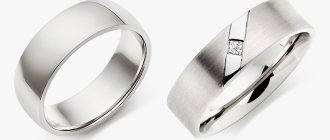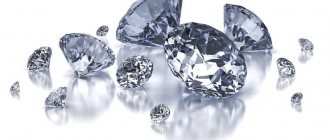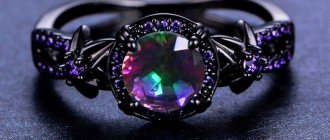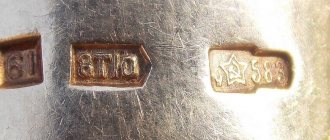Looking at the counters of jewelry stores, you simply get lost in the shining luxury of jewelry of all kinds of designs. It would seem that every person, no matter how demanding he is, will definitely find a ring to his liking.
However, making rings from gold and silver is a fairly popular service provided by many jewelry workshops. Moreover, in large cities (especially in the capital), more and more new studios are appearing where rings of original designs are made.
The cost of custom-made jewelry is significantly higher than the price of factory jewelry. Nevertheless, clients do not stop going to private workshops and ordering jewelry, analogues of which they could purchase in stores.
One of the attractions that attracts customers is the service of making rings from the customer’s gold. Let’s figure it out together what this looks like in practice.
What gold items will the new jewelry be made from?
Making rings from your own gold to order is not as profitable as it seems at first glance. In terms of price, designer jewelry is clearly superior to mass-produced jewelry - the process of making jewelry by hand is long and painstaking, and not a single craftsman will work at a loss.
Making wedding rings from your own gold is justified only in a few cases:
- You have enough scrap at your disposal to cover the cost of making a new ring.
- It is important for you that the new decoration be made from the old one (we warn you: this is not always realistic).
- You want to get a truly exclusive piece of jewelry and are willing to pay a lot of money for it.
Not all workshops undertake the manufacture of products from the customer’s gold. The exception is 999 fine gold bars. All workshops work with it without restrictions.
Not every gold item (or scrap) will be accepted for making new jewelry. This is only possible in the case of modern products with the Russian Federation hallmark. They can be practically new, worn out or even damaged, but they must have a hallmark and a name tag (the signature stamp of a licensed master or manufacturer).
Main types of chains to order
It is very easy to order a chain in our workshop - just a call or online request. But personal communication will be especially productive, comfortable and enjoyable for you. Our office in the center of Moscow will hospitably welcome you; specialists will provide a free consultation on all issues and introduce you to jewelry samples.
Custom-made chains differ in size, metals of manufacture and types of weaving. The studio's catalog presents jewelry chains in their entirety.
The main types of weaving chains to order:
Anchor
Identical links are connected perpendicularly to each other, visually forming a real anchor chain. It has a lot of subtypes and is suitable for women, men and children. Chains with this weave are ideal for wearing pendants and pendants.
Bismarck
Leading in popularity among men. Technologically, weaving is very complex at every stage of production. The weaving is a fantasy connected links, which consist of several multidirectional rings. Custom-made chains with this weave are the most durable. They have many subspecies. The price depends on weight and metal.
Pantsirnoe
A very popular high-strength weave, suitable for men and women, visually reminiscent of ancient chain mail or armor. The links are located in the same plane and have a smooth surface. Custom-made chains using this technology are very comfortable and also have a lot of variations.
Fox's tail
Massive, luxurious weave with an intricate pattern of fancy links. It can have a round, oval and square section. The custom-made chain “Fox Tail” is very loved by men and looks great in an ensemble with a bracelet of the same weave.
Rose
An elegant, complex openwork weave consisting of links reminiscent of rose flowers. This is an exclusively female option. The weaving is fragile and capricious; it looks especially beautiful in red gold. The custom-made “Rose” chain is beautiful solo, but in a thinner version it goes well with a pendant/pendant.
Tourniquet
The discreet and noble design of the chain, reminiscent of a twisted cord, is loved by both women and men. Thin versions go well with pendants.
Glider
Fantasy links connected by a hinge or elastic and elastic springs. Has an endless variety of design solutions. Pairs wonderfully with similar bracelets. Making custom chains in this weave requires the talent of a designer.
Is it possible to make rings from old and foreign gold?
Some of our compatriots have accumulated a lot of old gold, inherited from their mothers and grandmothers. It was made in Soviet times and is decorated with an hallmark with a star.
At that time, 583 gold was popular, now superseded by 585. This means that no one will put a modern hallmark on a product melted from Soviet gold. Therefore, making and selling jewelry melted down from Soviet gold is illegal. There is a real criminal penalty for this.
585 gold ring with cubic zirconia (go to the SUNLIGHT catalogue)
Nevertheless, the workshops accept products made from old Soviet and foreign gold that do not meet modern Russian standards. But jewelry is not made directly from this metal: it is sent for refining. In Russia there are about ten state-owned enterprises that refining scrap precious metals. It comes there from workshops, pawn shops and purchases.
Refining is the purification of gold alloys from impurities (ligatures). Technologically, this is a very simple process that can be done even at home, but it is illegal. Therefore, all scrap precious metals (including items made from Soviet gold, crowns, denture discs, etc.) are processed exclusively at licensed enterprises.
Where do impurities come from in gold? The fact is that pure gold is a metal that is slightly harder than plasticine. A product made from it could be bent with two fingers and scratched with a fingernail. To achieve the required hardness, other metals (ligatures) are added to gold - copper, silver, platinum, palladium, and so on.
The amount of additives determines the gold standard. For example, the most popular jewelry alloy, used to make most rings, has a purity of 585. This means that a kilogram bar of this alloy contains 585 grams of gold and 415 grams of alloys.
So, at the refining plant, the scrap is cleaned of alloys and ingots of almost pure 999 fine aurum are obtained. Ingots of this soft metal are sold to banks, jewelry factories and workshops.
Soviet gold has always had a pronounced reddish color. This means that it was made with the addition of a large amount of copper. White gold is made by adding platinum, silver, palladium, nickel and other white metals.
In the workshops, gold bars are obtained, the required amount of alloys are added to the aurum to achieve the desired color and physical characteristics, and jewelry is made from the resulting alloy (including rings).
Then all the jewelry made is sent to the local office of the Federal Assay Supervision, where they receive hallmarks: an assay mark, with the coveted numbers and a woman’s profile in a kokoshnik, and a name tag, that is, a name stamp containing the encrypted code of the manufacturer (in our case, the workshop).
Gold ring with hydrothermal emeralds (go to the SUNLIGHT catalog)
Summarizing the above, we can conclude: workshops accept almost any scrap of precious metals, but they evaluate it and send it to the enterprises for melting.
The cost of the scrap will count toward the price of the new jewelry, but it will most likely be made from metal that came from the refinery. So, most likely, it will not be possible to make an engagement ring from earrings inherited from your grandmother. In this case, it is more economically profitable to hand over old jewelry to a pawnshop. They will be checked, weighed, assessed and the corresponding amount will be taken into account when you purchase new jewelry from the existing range. Or you can just take it with money!
In Russia, all manipulations with precious metals are strictly controlled by the state, but this practice is not typical for all countries. Therefore, gold items brought by tourists from Turkey, Greece and Egypt almost always do not correspond to the numbers indicated in the sample. And enterprising Turks often sell jewelry without stamps, but they put any stamps at the buyer’s request.
FAQ
What are the guarantees for the quality of the materials from which your products are made? First, we have all the necessary permits for working with precious metals and stones. We are also registered with the Russian State Assay Chamber. All products manufactured by us are tested in the assay office, as evidenced by the corresponding stamps. Secondly, we work only with high-quality stones from official dealers. And at your request, we can conduct a gemological examination of stones and issue a passport. And most importantly, we are not interested in deception, as we value our clients and value our reputation! Which gold is better: Italian, Turkish, Russian, Chinese? Gold is not Russian, Turkish or Chinese. Of course, the alloy can be made in China, but this doesn’t say anything except the place of manufacture. The value is characterized primarily by the breakdown of the alloy. Fineness is the amount of pure precious metal in the alloy, for example, the 750th standard is 75% pure gold, and the 585th is 58.5%. The higher the standard, the more expensive the alloy, because alloys (additives), which use silver, copper, nickel, zinc, etc., are much lower in value than the price of pure gold. Alloying components change the properties of the alloy, including strength and color. This is how white or rose gold is obtained. Whatever the alloying components, the alloy will still have a warm tint, because The main component is yellow gold.
Do you work with customer material? Making jewelry from your own gold is the most asked question! We answer: Yes, of course we manufacture jewelry from the customer’s material! This will significantly reduce the cost of the order. Since gold and stones make up the bulk of the price of jewelry. A combined option is also possible. If your material is not enough to complete the order, we will add our own!
How many carats is this? The word "carat" comes from the name of the pod of the carob tree (Ceratonia siliqua). The seeds of which served as a measure of weight in ancient times. A carat is a unit of measurement of mass and volume, usually used in relation to precious and semi-precious stones, and is also used to measure fineness of gold 1. Carat as a unit of mass A carat is a unit of weight, not size. We would like to emphasize this point because many people think that a one-carat stone is a special size and that therefore, for example, a one-carat diamond and a one-carat emerald should look the same in size or external parameters, but this is not the case. If you compare a one-carat diamond with an emerald and a one-carat ruby, you can easily see this. Firstly, emerald is lighter than diamond, and diamond is lighter than ruby. This means that a one-carat emerald will look larger than a one-carat diamond, and a ruby will look smaller than a diamond. Emerald, having a lower density, has more volume per carat, and ruby, being heavier, has less volume per carat.
Ratio of diamond weight to diameter:
Weight 0.03 ct = diameter 2.0 mm; Weight 0.10 ct = diameter 3.0 mm; Weight 0.30 ct = diameter 4.3 mm; Weight 0.50 ct = diameter 2.4 mm; Weight 1.00 ct = diameter 6.5 mm; Weight 2.00 ct = diameter 8.2 mm; Weight 3.00 ct = diameter 9.4 mm. 2. Carat as a unit of measurement of the purity of a metal alloy (sample). Another meaning of the term is the content of pure gold in the alloy, measured in 24 parts of the total mass. In international trade, karats (British karats) traditionally express the percentage of purity of gold in an alloy. It is believed that pure gold without any impurities has a purity of 24 carats (24 k). Our pure gold is equal to the fineness of three nines (999.9). 24 k=999.9 . This measure is used in 23 countries. In Russia, “proba ” (from the Latin “Probo” - I evaluate, I test). Fineness is a measure of the gold content of jewelry.
- 585 standard = 14K - 750 standard = 18K - 958 standard = 23K - 999.9 standard = 24K (pure gold).
Master class on making jewelry
The Internet is replete with all kinds of master classes on making rings at home. Many of them provide fairly detailed recommendations and descriptions, but once you read them, you understand why jewelers charge such high fees for their services.
To make rings with your own hands, you need to purchase a lot of equipment and available materials: a crucible, cutters, a soldering iron, wax, silicone, plaster, acids, all kinds of shapes and containers, and much more. And this is not counting the precious metal, which can simply be ruined if handled improperly.
In the workshops, gold rings are made by experienced jewelers who have an extensive arsenal. And they learned their art not from gold, but from simpler metals.
By purchasing a machine for making rings, you will not automatically become a jeweler. You need to work long and hard before you start actually working with precious metals. By the way, without a license it is illegal: just sell or give away a handicraft product and you will commit a crime.
How is the cost of the finished product determined?
The actual cost of the work is calculated based on many factors:
- Material price. The more high-grade gold the master uses, the higher the cost of the final product. And when making, for example, a silver ring, the price of the material is, of course, taken into account, but it takes a small share in the final pricing. We must not forget about the cost of precious stones, and it can also be quite large.
- Difficulty of work. A complex model will naturally cost more than a smooth wedding band. The most affordable option is to choose a product from the proposed catalog: the workshop will already have special forms in stock, which will reduce the cost and time of work. Jewelers work much longer on individually designed models (according to an exclusive layout), which is reflected in the price.
- Technological nuances. For example, an engagement ring can be made in two ways. First: a narrow gold plate is cast, closed in a circle, welded and polished. With a professional approach, the product is obtained without any traces of seams. The second option: take the appropriate mold, pour hot jewelry alloy into it - and get a monolithic piece of jewelry. The second method is much more expensive, but many clients prefer it.
The workshops do not make absolute copies of popular brand models - no one needs copyright problems. But you can order a product very similar, for example, to a Love ring or a “nail” from Cartier. There will be a difference in nuances, but only a specialist will be able to notice it.
For a lasting memory: make wedding rings
For such a significant event as a wedding, many clients, instead of buying stamped products, prefer to make custom wedding rings
. Handcrafted by talented craftsmen, these rings become very personal symbols of love, devotion and family happiness.
The variety of design finds and design solutions of the workshop is amazing: rotating wedding rings, crown rings, “Space” and “Sea Knot” models, wedding rings bearing the names of spouses or their initials in intricate patterns, and even rings made of valuable wood species as a gift for a “wooden” wedding.
Order rings that will be specially designed and handmade just for you or your loved one.
Production time
If you want to have a custom ring made from your own gold, you need to be patient. It is extremely rare that you can go for finished products in a couple of weeks.
In most cases, the process lasts for one and a half to two months, especially if we are talking about an exclusive product designed by the customer.
Gold ring with diamonds in the SUNLIGHT catalog










